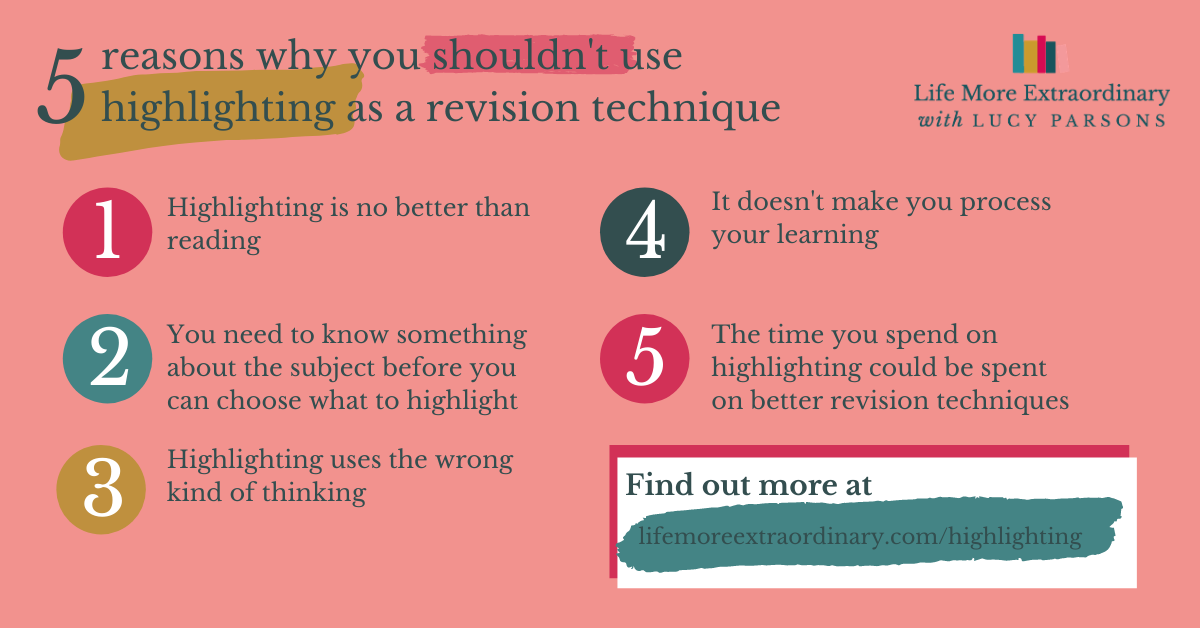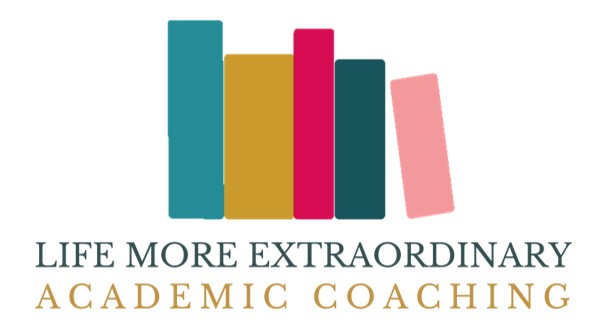Why you shouldn’t use highlighting as a revision technique (and how you can use highlighters instead)
Podcast: Play in new window | Download
Subscribe: RSS
Highlighters are one of those stereotypical revision tools that always get added to the shopping basket when people are buying their revision stationery. However, highlighting is one of the very worst revision techniques you can use.
In this blog post and podcast episode, I'm going to explain why highlighters shouldn't be used as a revision technique, and how you can use them instead.
Why highlighters are terrible for revision
To be honest, the science isn't 100% conclusive about highlighters as a revision tool, but it's clear that they're not as good as other techniques like doing past papers. In his book, Exam Literacy, Jake Hunton sets out some reasons why highlighters aren't rated highly in helping students to revise effectively.
1. Highlighting is no better than reading
In a study, cited by Hunton, that was published in Scientific American and Science three groups of students were tested after learning material in different ways.
One group simply read the material, another group highlighted as much as they liked and the third group read texts that had been previously highlighted by someone else. The group that only read the material, with no highlighting, performed the best on the test.
2. You need to know something about the subject before you can choose what to highlight
I can remember being asked to read and highlight articles when I was doing my A-Level geography at school. I would basically highlight the entire article, because, to me, all the information was important.
This is clearly pointless, the purpose of highlighting being to pick out the bits of the text that are relevant. The problem is, if a student doesn't have the necessary background knowledge or confidence in their own judgement about what's important and what isn't in a text, then they might:
- Highlight everything; or,
- Highlight the wrong things
3. Highlighting uses the wrong kind of thinking
If you're highlighting as a revision technique, you're aiming to be able to understand and, crucially, remember the information that you're highlighting.
However, if you're thinking too hard about what to highlight, you're using a mechanism in your brain that's to do with analysis rather than retention so you're not storing that information effectively for the future. You may also be thinking about what to highlight, rather than the ideas, concepts and facts in the text.
4. It doesn't make you process your learning
The most effective learning involves taking an input (what you're learning), processing it in your brain and creating an output – ideally the answer to an exam question. Highlighting doesn't produce an output that students have changed from the input in any meaningful way so there's no deep learning or memorisation going on.
5. The time you spend on highlighting could be spent on better revision techniques
We've all only got 24 hours in the day. If you choose to spend some of your revision hours on a technique like highlighting, rather than doing something far more effective like a Revision Power Hour, you're going to:
- Have to do either many more hours of revision than necessary; or,
- Get a lower grade than you should in your exams.
Why waste your time on something rubbish when you could get better results in way less time with another technique?
How you can use highlighters successfully
So, if you shouldn't use highlighters for your revision, what can you use them for?
1. Categorising information and planning
When I was at university I would read about ten texts from my reading list before sitting down with my notes to plan the essay that I needed to write.
I would go through my notes with different highlighters re-reading them and using the highlighters to categorise different sections of the notes. This would make it much easier for me to find the right information for each paragraph when I was writing the essay.
Ways you could use this at school could be for subjects like history and geography using different coloured highlighters to pick out the economic, political, social, physical etc. causes or effects of an event. In English, you could pick out particular devices or forms of language so they're easier to identify when you're writing about them.
These activities can help with revision, and particularly generating revision materials, but they are not revision in and of themselves.
2. Adding emphasis, meaning and association in revision notes and flashcards
When you're creating revision resources like flashcards and revision notes, you can use highlighters, and other forms of colour to:
- Pick out important things like keywords giving them emphasis
- Create a colour association with a certain topic or subject e.g. you always use purple highlighters for chemistry key words, associating the colour purple with chemistry
- Highlighting explanations in a different colour
You should be looking to develop your own system for how you create your own revision resources that's meaningful to you – so play with this until you have a system that makes sense and works for you. However, the gains from using highlighters in this way are probably marginal, if not negligible.
“If I shouldn't be highlighting, how should I be revising?”
You might have got this far and thought, “That's all very well knowing why I shouldn't highlight, but what revision techniques should I be using instead?”
That's a very valid question.
The most important thing for you is to first understand how learning works. I've hinted at this here (having a learning input, processing it in your head and creating an output). However, in the Optimise Your Revision Techniques module in The Extraordinaries Club I explain to you how this process works and the key revision techniques that work and everyone should be using. There are also videos detailing how to use some of the most popular revision techniques effectively.
To access these resources, join The Extraordinaries Club.
